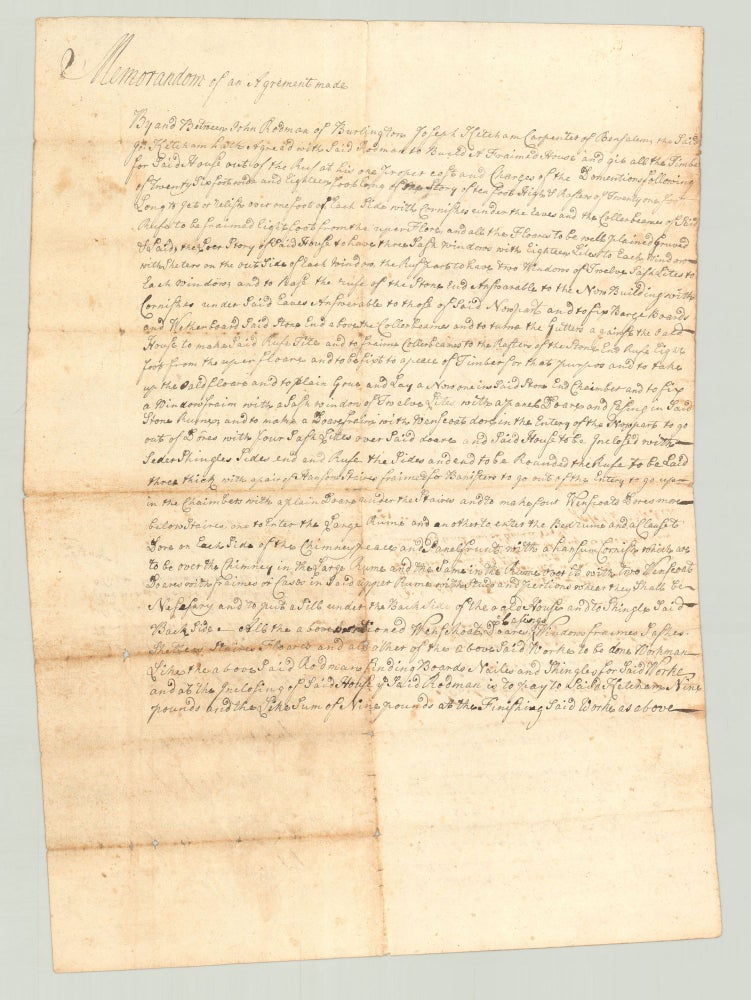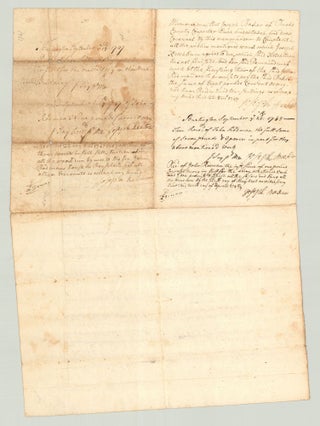Memorandum of an Agreement made.
Burlington, New Jersey, 1747–1748. 4to (15.75” x 11.5”). 2 pp. of manuscript. A fascinating colonial house construction contract, detailing architectural specifications and terms of labor, between New Jersey and Pennsylvania landowner John Rodman (1679–1756) of Burlington, New Jersey and two consecutive carpenters he hired to construct a house in Bensalem, Pennsylvania. This memorandum records agreements between Rodman and carpenters Joseph Ketcham Jr. (1715–1809) of Bensalem and one Joseph Baker. The specifications require Ketcham (and subsequently Baker) “to build a fraimed house and git all the timbe[r] for said house out of the ruf [roof] at his one [own] proper cost and charges of the Domentions following of Twenty Six foot wide and Eighteen foot long of one story of ten foot high & Rafters of Twenty one foot long.” Several references indicate that the construction undertaken involved an older structure as well. Specifications are given for eaves, beams, doors, stairs, floors, cornices, windows, window frames, closets, bedrooms, gutters, banisters, shutters, sills, shingles, and so forth. The main contract here, which covers all of one side of the sheet, stipulates that Rodman will pay Ketcham nine pounds before he finishes the house, and nine pounds upon completion. The agreement reads in part: all the floars to be well plained, gruved & Laid, the loer story of said house to have three sash windows with eighteen lites to each window with sheters on the outside of each window, the ruf part to have two windows of twelve sash lites to Each window; and to rase the rufe of the stone end answerable to the new building with cornishes under said eave…to make a doare fraim with wenscoats done in the entery of the new part to go out of dores with four sash lites over said doares and said house to be inclosed with seder shingles sides end and rufe the sides and end to be rounded the rufe to be laid three thick with a pair of hansum staires fraimed for banisters to go out of the entery to go up in the chaimbers with a plain doare under the staires and to make four wenscoats dores more below staires, one to enter the large rume and an other to enter the bedrume and a clauset to be over the chimney in the large rume and the same in the rume over it with two wenschoats doares with fraimes… Notes on the recto indicate that Ketcham received nine pounds from Rodman on 19 Sept. 1747—one half of his promised pay. In the next entry on 22 Sept., Ketcham records he received “three pounds in full satisfaction for all the work dun by me to his son John Rodmans house in Bensalem and all other accounts.” The next note records a change of labor: “Joseph Baker of Bucks County carpenter have undertaken and does covenant by this memorandum to complete all the within mentioned work which Joseph Ketchum agreed to do which said Ketcham has not finished and for said remainder of work at the finishing their of the said John Rodman doathe promise to pay the said Baker the sume of eight pounds current mony and have rec’d in hand ten shillings as witness my hand this 22 Jun[?] 1747.” On 26 Sept. 1748, it is recorded that Baker received from Rodman “the full sume of seven pounds & 3 pence in part for they above mentioned work.” The final entry notes the receipt from Rodman of “the just sume of one pound current mony in full for the above mentioned work.” Baker promises “to finish all the sashes and hang all the windows by the first day of May next as witness my hand this tenth day of April 1748/9.” Born in Barbados, raised in Newport, Rhode Island, and residing for some years on both Block Island and Long Island, Dr. John Rodman purchased 422 acres of land in Burlington County, New Jersey in 1726 and settled there. A Quaker, Rodman was a member of the Ninth Assembly of the Province of New Jersey (1727–29). In 1738, he was elected a member of the Board of Aldermen of the city of Burlington, and from then until his death he acted as King’s Councillor for New Jersey. Rodman was appointed by King George II in 1741 to settle a controversy that had arisen between the Mohegan Indians and the colony of Connecticut over the Indian reservations in that colony. Later in life Rodman owned over 1300 acres of land in Burlington County and two plantations in Hunterdon County. The Camden & Amboy R.R. which passed through Burlington was laid out over an old graveyard that served as the burial-place for Rodman’s slaves. Rodman was described by the incumbent New Jersey Governor Lewis Morris (1671–1746) as “a Quaker, a man of good temper, of a good estate in Jersie and Pennsylvania, and generally well esteemed both by Quakers and others.” After living in New Jersey and then Maryland during the Revolutionary War, Joseph Ketcham Jr. and his family traveled down the Ohio River in a flatboat to Louisville, Kentucky, landing there in May of 1784. From there the Ketchams went east some fifty miles and settled in the part of Jefferson County which became Shelby County in 1792. Eighteeenth century house contracts are rare, particularly those preceding the Revolutionary War. REFERENCES: Jones, Charles Henry. Genealogy of the Rodman Family, 1620 to 1886 (Philadelphia: Allen, Lane & Scott, 1886,) 18-20 pp.; The Ketcham Family History at iamonia.tripod.com CONDITION: Original old folds, a few letters to words clipped at margins of the document, but no other losses to the text.
Item #5751
Sold



